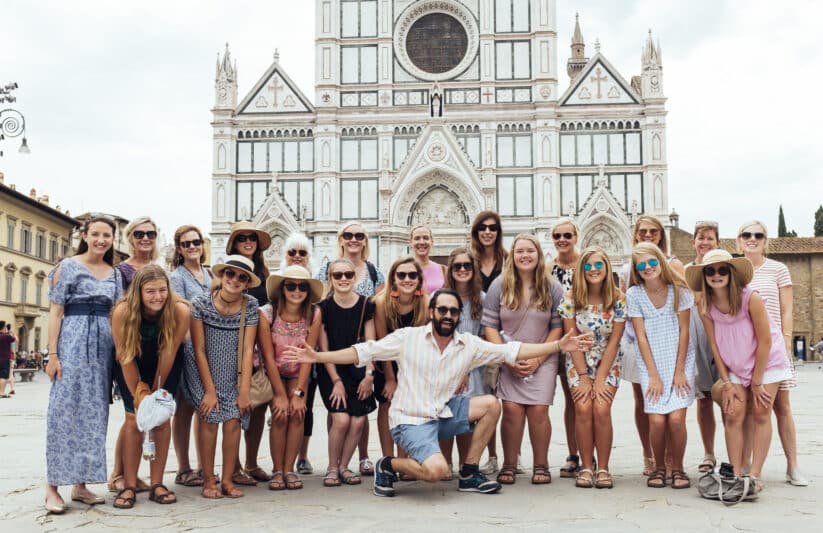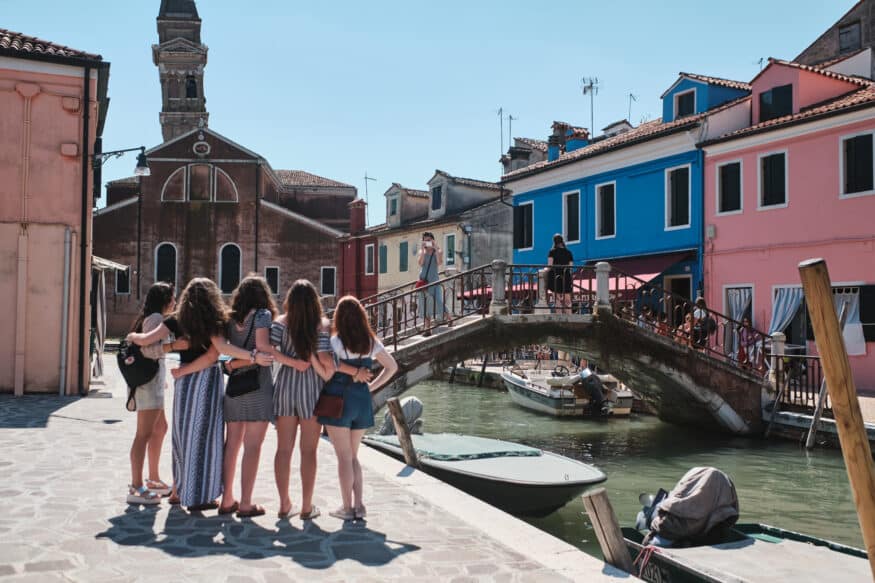8 Helpful Travel Tips for Italy

Italy is one of the most popular destinations in Europe, with a reported 75 million people visiting in 2022 alone! The culture, food, history, and sunny climate are a massive draw for ACIS groups, and we are always thrilled to provide them with a taste of La Dolce Vita. To help you plan your perfect trip, the expert team at ACIS has gathered 8 key travel tips for Italy. Share your top recommendations in the comments!
1. Pack Layers
No matter what season you’re heading to Italy, you will want to bring clothing layers for a variety of climates and cultural norms. Heading to seaside towns like Livorno and Sorrento calls for a windbreaker, while the alpine regions of Lombardy and Pidemont may require a sturdier sweater, especially in winter.
It’s also important to bring at least one clothing item that covers the shoulders and a pair of pants or skirt that hangs below the knee. In order to enter many of Italy’s churches, including the Sistine Chapel, you will be asked to cover the shoulders and knees out of respect. Some chapels provide paper covers but don’t count on those being available if there’s something you really want to see!
Check out our full list of packing tips for international travel
2. Learn Key Italian Phrases
Trust us when we say an attempt to learn basic Italian for your travels is going to be met with a warm welcome! Don’t feel as though you need to be fluent and instead focus on key, commonly used sayings that will help you navigate your time abroad. Examples include:
- “Hello” and “goodbye”
- “Please” and “thank you”
- “I would like to order….”
- “Where is the restroom?”
- “How much is it?”
There are apps like Duolingo that can help you master these basic phrases. We also recommend podcasts designed for language learners that provide grammatical information as well as additional travel tips for Italy.
Download Free ACIS Visual Vocabulary Guides
“My students are changed. They see the world differently now. We covered a lot of ground, but they definitely now have an introduction to Italy, its people and its history.“
— Robert C., ACIS Group Leader

3. Note the Breakfast Differences
Before you set out on a day of exploring, you’ll want to grab an Italian breakfast. But unlike in the United States, where hearty fare like bacon and eggs are the norm, a traditional Italian breakfast is lighter and sweeter. A simple pastry such as a cornetto or sfogliatella and an espresso is a very common way to start the day. But remember the upside: Lighter breakfast is just another reason to stop to refuel with gelato during the afternoon!
4. See the Small Towns
Many first time Italy travelers are understandly drawn to the capital of Rome: It is an incredible city with plenty of energy and modern amenities that also still feels like a page from history. We definitely recommend having a stop in Rome be part of your itinerary, but suggest supplementing your city adventure with some of the smaller Italian towns. Consider Verona, the birthplace of Romeo and Juliet, or a day trip to Assisi, where there is a beautiful medievel basilica dedicated to St. Francis, born in the city in 1181. In these quieter places, you can get a sense of every-day Italian life, and enjoy cuisine that is pulled straight from the local area.

5. Eat Slow, Local and Traditional
Across Italy, you’ll see food labels reading Denominazione d’Origine Protetta (DOP), meaning Protected Designation of Origin. This badge of honor signifies a specialty product that comes from a specific region and nowhere else. Italy has some of the most famous DOP products available – and actually has the most number of them under the EU protection – from Prosciutto di Parma and Parmigiano Reggiano to Pasta di Gragnano and Pomodoro S. Marzano. You’ll want to take advantage of trying these beautiful ingredients, especially right in their regions of origin.
The slow food movement is also credited with having begun in Italy. Ingredients come farm-to-table and there is an emphasis on enjoying the meal at a slower pace. You may also find dinners are later in the evening, so don’t be surprised when you see diners sitting down at 9 or 10 at night. Don’t worry: On an ACIS Tour, you’ll be eating earlier!
6. Bring a Reusable Waterbottle
Skipping out on plastic bottles is one of our top tips for traveling sustainably. It is estimated that by choosing a reusable waterbottle, an average person can save 156 plastic bottles from being wasted per year. In Italy, there is also a unique cultural experience to be had with your refillable bottle in hand! Across cities such as Rome and Florence are fountains with clean, potable water ready to drink. In Rome, you can even filll your bottle at historic art pieces, such as Bernini’s Fontana della Barcaccia at the Spanish Steps.
View this post on Instagram
7. Plan Ahead for the Afternoon Riposo
You’ve spent the morning on a sightseeing adventure, and after lunch, you think to yourself “now is the perfect time to souvenir shop!” You’re ready to pick out a postcard to send home when you discover… the stores have all closed.
Prepared travelers know that in Italy, the hours between 1-3 PM are the time of riposo, the afternoon rest. Just as Spain has the siesta, Italy has an afternoon break where shops closed up for several hours to give workers a rest. If you’re looking to shop, try the mornings or evenings, and be sure to check visiting hours for area attractions.
“Not only did we see the most fabulous sites in Italy, but we also ate real Italian food and really saw the culture. Our Tour Manager, Ian, was responsive to every need, patient beyond words, kind and knowledgeable. Great hotels, great experience. Cannot wait to plan another!”
— Colleen S., ACIS Group Leader
8. Embrace the Passeggiata (The Evening Stroll)
One of the delights of traveling in Italy is that the evenings are leisurely, made to help you unwind after a long day. After dinner, you’ll find locals on una passeggiata, an evening stroll, enjoying the sights and sounds of the city. While Italian culture varies from region to region, this is one of those activities you can find almost everywhere you go, and you may just find yourself wanting to bring it home to the US when you return! For many group leaders, a key factor in choosing ACIS is our centrally located hotels, which means you can enjoy the passegiata and other evening activities in the city, rather than having to stay outside city limits.
Travel to Italy with Your Students
Looking to use these travel tips for Italy to plan an educational tour? ACIS Tours can help! With a dedicated team of experienced travelers, we can custom-build your Italian adventure to include history, culture, and plenty of good food. You’ll stay in centrally located hotels to save on commuting time, travel with the best Tour Managers in the industry, and access 24/7 support out on the road. Get started by giving us a call or download our 101 guide to planning an educational tour below.










